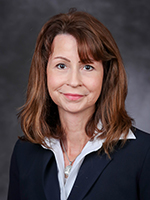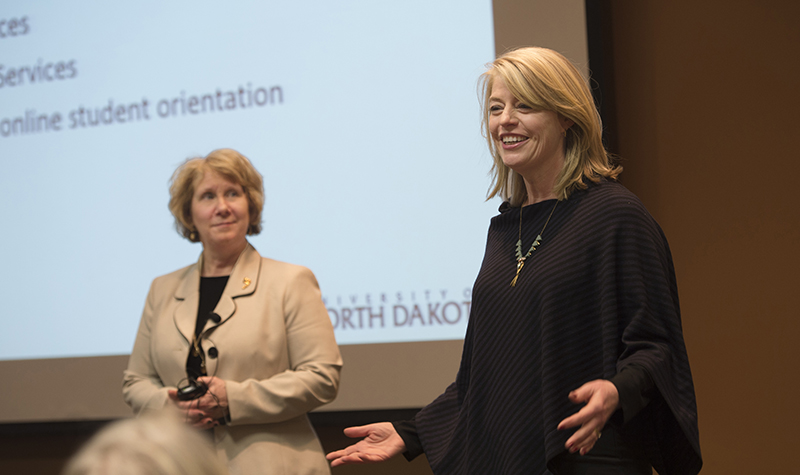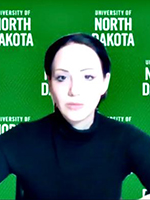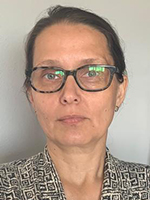TTaDA workshops cover campus life from A-Z
Year-round, UND’s Teaching Transformation and Development Academy keeps content current for institutional excellence

From quiet contemplation to lively discussion, the University of North Dakota is home to a wide range of academic activity each year.
And if that “A-Z” activity is happening on campus, it has likely been discussed at the Teaching Transformation and Development Academy.
TTaDA’s sessions are offered all year long and bring valuable information, advice and strategies to UND faculty, staff and graduate students. These sessions exist on top of the wealth of resources available on the Academy’s website.

The annual programming is shaped by UND’s strategic plan and priorities, current events and national news, as well as by suggestions from faculty, staff and students, said Lynette Krenelka, executive director for TTaDA.
“I am so proud of the work of the Teaching Transformation and Development Academy,” Krenelka said. “One of the areas that has really grown, thanks to Zachary Aubol, staff career and professional development coordinator, is the development and offering of just-in-time training for staff that’s available when UND employees need it.
“One of the best ways we can give back to UND is through sharing evidence-based practices and highlighting the expertise and innovation that faculty bring to their teaching. This leads to student success.”
For example, two workshops in recent weeks particularly embodied TTaDA’s vision of activity and dialogue. The sessions enlisted University experts to help their colleagues succeed in the classroom and in their careers as UND employees.
‘Kind attention’ for the mind
The first session, hosted by Aubol, “A Conversation with Staff about Well-Being and using a Mindfulness Approach,” indeed started with conversation, but ended with Zen-like poise and practice.

Tom Solem, director of the University Counseling Center, and Lora Sloan, the Center’s lead psychologist, spoke to UND staff members about mental health through the lens of the ongoing pandemic. As uncertainty lingers two years on, both in work and daily living, so can intense feelings of fear, worry and hopelessness, they said.
That type of “trauma existence,” as psychologists term it, can make it harder to go through the motions or take on additional stress.
“As plans change and the way you’re doing things is shifting, that can really impact the way you’re looking ahead,” Solem told attendees. “Things get cancelled or decisions are made that affect our outlook, and it’s not like only one thing has been cancelled or moved.”
Mindfulness is a scientifically validated practice that can help when the pressures become overwhelming, according to UND’s experts.

And, as Sloan demonstrated through a peaceful sensory exercise – in this case a minutes-long routine of steady breathing, physical relaxation and mental openness – mindfulness isn’t about practicing intense meditation in the ways people might assume. It’s also not about stopping thoughts or emotions, she added.
“On a given day, we have as many as 30,000 thoughts, and about 80 percent of them are negative because of our brain’s negativity bias,” she said. “The brain wants to tell you all of the bad things that could happen. We have this elaborate ability to tell ourselves stories, which is not super helpful most of the time.”
Thus, mindfulness can be considered a “kind attention.” Sloan admitted that the term doesn’t sound scientific, but kindness is a powerful force in people’s lives. Inclining one’s mind to kindness – connecting with the present moment with acceptance and willingness – can help in navigating stress.
“When we learn ways to do this, how we experience things changes,” Sloan said. “The experience changes when we feel more able and willing to accept what’s happening and work with it.”
Sloan later pointed attendees to a list of sources to consider as they work to include actions of mindfulness in their weekly routines, including sites such as calm.com and mindful.org. But, ultimately, it’s all about what works best for the individual.
“Over time, it’s been really important to me not just professionally, but personally, to consistently work on these things daily,” said Solem, offering his own perspective on the practice. “Early on, it doesn’t feel like there’s time to take 10 or 15 minutes to slow down and give mindfulness that time. But we can afford to give ourselves that break.”

Faculty panel talks DEI
The following week, conversations shifted to the classroom – to a topic becoming more prominent in UND’s work and in academia overall.
Led by Anne Kelsch, director of faculty development for TTaDA, a panel of four UND faculty members fielded questions about diversity, equity and inclusion as a topic of classroom discussion. Titled “Being Better Prepared to Navigate Classroom and Student DEI Conversations,” the panel shared strategies and recommendations for handling what can develop into difficult or contentious conversations around DEI.
Kelsch prompted the panelists to talk about their experiences, both in developing course material that addresses issues of diversity as well as how they conduct their classrooms to create productive discussions.
“It’s quite understandable if you’re fearful, anxious or stressed about engaging in these topics with students,” Kelsch said. “We want to acknowledge that as a reality of the work that we do. We don’t want to pretend that there aren’t challenging things you’re thinking about confronting in teaching.
“Oftentimes, in our minds, a potential student response is outsized and perhaps beyond our ability to manage. More often than not, student responses are understandable human responses that we can prepare for. So, we thought it would be helpful to talk about what others have experienced, and how they’ve framed the conversation.”
Panelists taking part were Zarrina Azizova, assistant professor of higher education and director of the higher education master’s program; Cerynn Desjarlais, clinical assistant professor and graduate program director for the master’s and postgraduate certificate counseling programs; Andjela Kaur, assistant professor in rehabilitation and human services and Jessica Zerr, administrative director of composition in the English department.
Commitments to continued growth

Despite their distinct contexts for engaging in DEI topics, based on their respective fields of study and teaching environments, some common threads emerged throughout the hour-long session.
Desjarlais, in talking about strategies, said she starts by properly setting the stage for a safe classroom environment. As instructors and professors acknowledge their own areas of privilege or oppression, she said, they set an example that acknowledges identity status, fallibility and a willingness to learn.
“I let them know that these conversations can be difficult, and there are many perspectives,” Desjarlais said. “Also, that it’s important to be respectful of that fact and acknowledge that some people are in different places of thinking around these topics.

“We’re all fallible human beings who will make mistakes, but there also needs to be a commitment to educate ourselves and move forward together in that growth. So, I really try to frame the classroom as an area where we can make mistakes and help others recognize how they can grow past that.”
Kaur, following that, said she likes to set the stage by having students introduce themselves, though with a twist: how do others see them, and what do others get wrong about them in that perception?
“In the process of responding to each other, we already expose this idea that there are many viewpoints about simple things such as ourselves,” Kaur said. “From the beginning, it’s established that we’ll be working with these different points of view and deliberating between them.”
Student engagement strategies
Panelists also responded to questions of what to do after those early strategies, once students have the floor in engaging with topics that can evoke discomfort, disparate opinions and defensiveness.

For example, when students react to course content in an unproductive or passive aggressive way, such as saying they won’t read a certain text or answer a certain test question, Zerr sees that as a call to curiosity rather than defending the content.
“Very quickly, I realized that defending my stance or content selection locked us into a very unproductive place,” Zerr said. “Be ready to pull back the curtain and reveal why that certain text is involved, or why the conversation is taking place. Letting students know of our thinking is a way to get past that defensiveness.”
Azizova agreed. Furthermore, even that process of sharing one’s thinking must be done with understanding, especially because not everyone shares her and her colleagues’ familiarity with DEI issues, she said.

“I’m a fact-driven person, and I love data,” Azizova said. “But when I talk about racism in the American higher education system that has existed for centuries, and I receive feedback saying we should stop talking about things that divide us, I can’t just confront that with more and more data. Instead, I start looking to literature and first-person accounts that can talk about the experiences at the intersection of race and class and higher education.”
The discussion turned to the differences between debate and dialogue in the classroom. Whereas debate is more centered in a legal framework, and in “winning” the argument, dialogue is about understanding the group’s lived experiences.
“If we can help shift and frame things from that perspective of dialogue, that can help people shift their reactions as well,” Desjarlais said.
Resources past, present and future
Though the faculty DEI conversation was limited to an hour’s length, Kelsch noted that attendees posting in the Zoom chat showed interest in more discussions. On the TTaDA website, there is a section dedicated to DEI resources, workshops and panels, some of which have been covered in previous UND Today stories.
Likewise, those who visit the TTaDA website can navigate to the “Programming” section to find upcoming events and workshops, as well as past sessions that have been recorded. Also available are additional resources such as webinars, podcasts and on-demand training for a variety of teaching, technology and interpersonal training topics.



